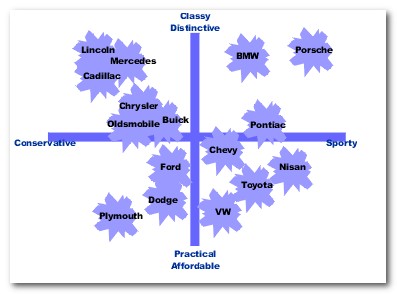Competitive Review
Once you've decided on a niche to target, you then need to determine the level of competition within that niche. No matter how good the SEO, if your competitors offer a better service, you're unlikely to see the payoff for all your hard work getting high rankings.
S.W.O.T
A SWOT analysis can help you determine how your site compares to those already in the niche.
SWOT stands for Strengths, Weaknesses, Opportunities and Threats. You perform this analysis on your own site, and those of your competitors.
SEO SWOT Method:
- Query the serps for the keywords you want to rank for
- Pick out the top few sites in your niche. The top sites will usually appear under a mix of keyword terms relating to your niche
- Determine the strengths and weaknesses of the competition
- Determine the strengths and weaknesses of your own site
This exercise need not take long. Whilst you can can go into incredible detail with a swot analysis, the key points are to identify what you are good at, and what the competition is good at. You're not looking at the SEO elements, you're looking at the service or product offering. If your site is informational, then look at the quality and quantity of information they offer.
Are there areas where you are better than the competition? If you can't find an area where you are better than the competition, either refine the niche you're targeting, choose another niche, or figure out a way to be *markedly* better than the other guys. Out-ranking them won't really help in the long run, because searchers seldom stop at the first site they find. They compare sites against each other.
This is why you don't necessarily need to outrank a site that offers a poorer service than you do, early in your campaign. You simply need to position against it. For example, your TITLE tag could be worded to show how your offer is better than theirs.
By going through this exercise, you'll also get a good feel for opportunities, and the level of competitive threat.
Barriers To Entry Are Your Friend
On the web, there are few barriers to entry. Anyone can start a website and copy your idea.
However, not everyone can start a Google. Or an Amazon. Or a Facebook. Those companies have barriers to entry in their markets, mostly to do with the scale of operations. It is very expensive to do what they do, and they're also entrenched as long-time crowd favorites. This barrier to entry plays to their advantage, and make s it very difficult to unseat them. Also, being the biggest, they also tend to grab the lion-share of revenue in their space.
Try to look for barriers to entry than are you can get over, but others can't. Is there something that will make it difficult for new entrants to follow you? Can you spend more money, or partner with someone to make your offer difficult top emulate? Can you leverage your personal reputation?
If so, you stand a good chance of fending off competitive threats from latecomers.
Beware Of Well Resourced Competitors
Can your competitors outspend you? Do they have more people working for them? Do they have waves of writers producing content and spreading the word?
It is difficult, although not impossible, to compete with such sites. You can work smarter. You can be more efficient. But your task will be harder than if your competitors have a similar level of resources to you.
In SEO terms, check out Mike Grehan's "Filthy Linking Rich" (PDF) for reasons why the rich get richer, especially in terms of SEO.
Perceptual Mapping
Perceptual mapping is a graphical technique that attempts to visually display the perceptions of potential customers. Typically the position of a product, product line, brand, or company is displayed relative to their competition.
Perceptual maps are very useful for finding unserved markets.
The Wikipedia example is a good one:

Cars that are positioned close to each other are seen as similar on the relevant dimensions by the consumer. For example consumers see Buick, Chrysler, and Oldsmobile as similar. They are close competitors and form a competitive grouping. A company considering the introduction of a new model will look for an area on the map free from competitors. Some perceptual maps use different size circles to indicate the sales volume or market share of the various competing products.
Do likewise for your niche, and look for areas of clear space. That's where the opportunity lies
New to the site? Join for Free and get over $300 of free SEO software.



Once you set up your free account you can comment on our blog, and you are eligible to receive our search engine success SEO newsletter.
Already have an account? Login to share your opinions.




Comments
Add new comment